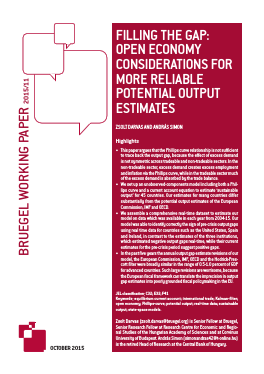Working Paper
Filling the gap: open economy considerations for more reliable potential output estimates
This paper proposes a novel structural model to estimate the equilibrium level of output and reports results for 45 countries. The model is conceptually more appropriate than existing methods by incorporating open economy considerations, which are completely missing from the models of the European Commission, IMF and OECD.
Highlights
- This paper argues that the Phillips curve relationship is not sufficient to trace back the output gap, because the effect of excess demand is not symmetric across tradeable and non-tradeable sectors. In the non-tradeable sector, excess demand creates excess employment and inflation via the Phillips curve, while in the tradeable sector much of the excess demand is absorbed by the trade balance.
- We set up an unobserved-components model including both a Phillips curve and a current account equation to estimate ‘sustainable output’ for 45 countries. Our estimates for many countries differ substantially from the potential output estimates of the European Commission, IMF and OECD.
- We assemble a comprehensive real-time dataset to estimate our model on data which was available in each year from 2004-15. Our model was able to identify correctly the sign of pre-crisis output gaps using real time data for countries such as the United States, Spain and Ireland, in contrast to the estimates of the three institutions, which estimated negative output gaps real-time, while their current estimates for the pre-crisis period suggest positive gaps.
- In the past five years the annual output gap estimate revisions of our model, the European Commission, IMF, OECD and the Hodrick-Prescott filter were broadly similar in the range of 0.5-1.0 percent of GDP for advanced countries. Such large revisions are worrisome, because the European fiscal framework can translate the imprecision in output gap estimates into poorly grounded fiscal policymaking in the EU.



